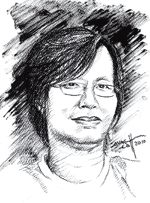
| By KYAW ZWA MOE | Monday, October 24, 2011 |
Six decades ago, Burma’s first premier, U Nu, described all Southeast Asian countries as “houses on stilts,” telling Time magazine that “As the wind blows, they go to and fro like this.”
At that time, many of the countries in the region faced instability and even chaos in their political systems and economies. Today, however, Burma is the last house on stilts remaining in the Southeast Asian bloc, and the people of Burma cannot afford any longer to “wait and see” if that will change.
The country has waited long enough.
 |
| Kyaw Zwa Moe is managing editor of the Irrawaddy magazine. He can be reached at [email protected]. |
In 1962, Burma was kicked by Ne Win’s military boot into a socialist abyss. It took 26 years before his authoritarian regime was removed in 1988, but then another military junta took over, disallowed the 1990 polls and waited two decades to hold another election, only to elect a Parliament dominated by the military and the junta-backed Union Solidarity and Development Party.
During that period, it took 15 years between the time a national constitutional convention was called and the current Constitution was ratified in a highly controversial referendum.
Today, some are saying that Burma is changing fast, but that is only relative to how slowly the country has changed in the past. Upon closer inspection, one can see that President Thein Sein’s current government is still taking its own sweet time.
Ex-general Thein Sein took over 6 months to make a decision about a prisoner release, and then he released only 220 of the approximately 2,000 political prisoners who have been waiting years or even decades to be set free. Suu Kyi herself had to wait for over seven years to be released from her latest house arrest.
Thein Sein met with Suu Kyi in August, four months after assuming power, and this was taken as a positive sign. But it should be remembered that former junta chief Snr-Gen Than Shwe—the man responsible for putting Thein Sein in the position of president—met with Suu Kyi in 1994, but it then took seven years for the second meeting to take place and another three years for the third.
So nobody knows how many months or years Thein Sein will take to meet with Suu Kyi again.
Some political scientists say that it takes time to change a country or its system, and in the past I expressed a similar point of view. But in Burma, change has taken an unnecessarily long time and the costs have been immeasurable.
While the people of Burma and the international community have waited for the country to change, the lives of generations of people have been laid to waste, along with the country’s educational system, economy and environment.
In addition, due to the civil war and political persecution, Burma is the biggest producer of refugees in Southeast Asia. Currently, there are around 145,000 Burmese refugees in nine camps along the Thai-Burmese border.
Since Burma’s army launched the ongoing offensive in June against the Kachin Independence Army based in the northern part of the country, nearly 30,000 war refugees have fled to the China-Burma border. Human rights abuses, including rape and forced labor, continue to be documented in connection with this conflict.
Burma also has produced millions of economic refugees, as the country’s decades-long bout of poverty and unemployment has forced workers to go to neighboring countries to find jobs. Corruption has been rooted in Burma for decades. Cronyism and nepotism are still hale and hearty.
Some observers, including Western diplomats and scholars, have welcomed the government’s initial steps towards reform, such as the suspension of work on the Myitsone Dam being built by a state-owned Chinese company on the Irrawaddy River, the meeting between Thein Sein and Suu Kyi, the relaxation of media restrictions and the release of some political prisoners.
But all of these steps were only half-measures that needlessly delay meaningful, irreversible change. Despite Burma’s history, real reform does not need to take a long time.
As just witnessed, it takes only two days for Thein Sein to issue an order and prisoners to be released. All political prisoners could be released in the same manner.
It takes only a few hours to drive from Rangoon to Naypyidaw, so Thein Sein’s next face-to-face meeting with Suu Kyi could occur immediately, and the discussions could continue until national reconciliation is achieved.
To make peace with the ethnic armed groups shouldn’t take months. If the government stops using these conflicts as negotiating pawns and treats all ethnic groups alike, the issues could be solved in short order.
There are many concrete reforms that could be instituted quickly and completely if the Thein Sein’s government has the political will to do so. Until this happens, Burma will remain a house on stilts.